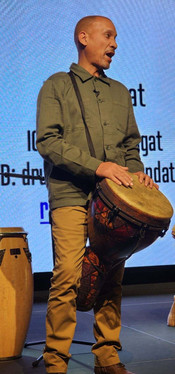Creative Lessons from Dr. Ram Bhagat On Discovering Our Innovative Potential Through Place, Identity and History
- Robert L. Dortch, Jr.

- Feb 22, 2024
- 3 min read
As we continue Black History Month, I find myself asking, "How open are we willing to be to delve deep into the rich tapestry of Black History beyond February and the wisdom it offers that can shape our approach to providing innovative solutions to a myriad of issues that continue to seek solutions? I'm reminded of Yvette Clarke's words, "We must never forget that Black History is American History. The achievements of African Americans have contributed to our nation's greatness."
Recently, Dr. Ram Bhagat brought this to life when he opened his Creative Mornings Richmond presentation with the beating of the drum to remind us of the powerful legacy of the drum in the African American story as he used it to call those gathered into collective mindfulness while creating a feeling of belonging before introducing us to innovative solutions to historical and contemporary issues and injustices that we continue to wrestle with as a community.
In sharing his personal story, Dr. Ram took us on a reflective journey of healing and hope that helped us to understand how science, story, identity, place and family can be a source of resilience, regeneration and resolution. Dr. Ram helped the Creative Mornings community better understand the interplay between our roots and having an innovative spirit. It led me to ask another pivotal question: How do our place, identity, history, and family impact our approach to innovation?
Identity and Place Can be a Foundation for Innovation.
As Dr. Ram shared, I was often reminded of home and the importance of place in helping to shape our identity and to inspire and influence who we are and the work we feel led to do. Our identity and the places we come from are not just points of origin but reservoirs of stories, struggles, and successes. They shape our worldview, influencing how we see problems and envision solutions. The narrative of overcoming in Black history teaches us that innovation isn't just about creating something new; it's about remembering where we come from and bringing stories that can help us reimagine possibilities to overcome today's challenges. How do we embrace our resilient roots as we forge inclusive, restorative, and transformative paths of innovation?
Leverage the Legacy of History and Family
Our history and families bestow upon us a legacy of resilience. Dr. Bhagat's emphasis on appreciating our ancestors underlines the importance of understanding that we stand on the shoulders of giants. Their struggles and victories are not just tales of the past but lessons that encourage us to push boundaries and redefine what's possible; by forgetting or seeking to erase or eliminate that history, we are at risk of losing a resource that is vital for inspiring future generations to dream new possibilities to today's and tomorrow's problems.
The Power of Community and Restorative Justice
In response to a question concerning the role of restorative justice in helping to address historical and current injustices, Dr. Ram showed us how an innovative initiative like Drums No Guns can thrive in communities that embrace restorative justice and collective healing. By acknowledging our interconnectedness, we can move from a mindset of 'power over' to 'power with.' This shift is crucial for leaders and entrepreneurs committed to fostering environments where innovation is driven by collaboration and a shared vision of success.
Reflective Questions:
How does your identity and history shape your approach to problem-solving and innovation?
What lessons from your ancestors or history inspire you to think differently about leadership and entrepreneurship?
Interactive Exercises:
Mapping Your Innovation Roots: Create a visual map that connects your identity, history, family, and place with your approach to innovation. Use symbols, words, and images to represent these connections. Reflect on how these elements have shaped your innovative mindset.
Ancestor Appreciation Letter: Write a letter to an ancestor or historical figure you admire, expressing gratitude for the lessons their life offers you as a leader or entrepreneur. Reflect on how their experiences inspire your approach to innovation and leadership.
In weaving the lessons of our identity, history, and community into our innovative endeavors, we honor the legacy of those who came before us and pave the way for a future where innovation is deeply rooted in understanding, collaboration, and justice.
As leaders and entrepreneurs who are willing to recognize and harness this rich legacy as a resource, we can transform our approach to innovation, making it more inclusive, empathetic, and impactful. Let us move forward, carrying the wisdom of our ancestors as a north star, guiding us toward a future where innovation solves problems and heals and unites communities because we understand that innovation is more than a mere product of the present; it is deeply rooted and watered by our history, identity, family, and place from which we've grown.

We would love to hear from you!
Share your experiences on this topic in the comments below















